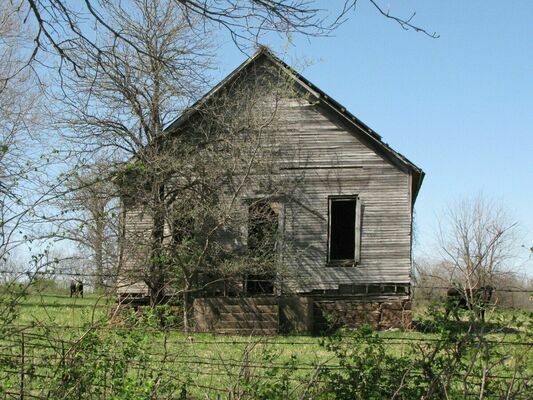Rural School Consolidation: The Consolidation and Reorganization Acts
 The former Carlock school as it now stands in a farm field south of Dadeville. After being re-formed from the private Dadeville Academy, the Dadeville public school system consolidated with several rural districts, including Carlock, to form one of the earliest consolidated school districts in the state, Dadeville C-2. Other early consolidated districts in Dade County included Arcola C-1 and Pennsboro C-3. The C-2 district continued to operate the rural one-room schools for a number of years after consolidation, as did the Arcola and Pennsboro districts. (Photo by James McNary)
The former Carlock school as it now stands in a farm field south of Dadeville. After being re-formed from the private Dadeville Academy, the Dadeville public school system consolidated with several rural districts, including Carlock, to form one of the earliest consolidated school districts in the state, Dadeville C-2. Other early consolidated districts in Dade County included Arcola C-1 and Pennsboro C-3. The C-2 district continued to operate the rural one-room schools for a number of years after consolidation, as did the Arcola and Pennsboro districts. (Photo by James McNary)
In Missouri, the term “consolidated school district” first emerged from statutes passed by the General Assembly to encourage districts to combine into larger units, and decrease the large number of small districts that in some cases took in an area best measured in acres rather than square miles.
In 1911, for instance, Dade County alone had 85 school districts, Lawrence had 104, Barton had 98, Greene had 124, Cedar had 88, Jasper had 122, and Polk had 112. The vast majority were rural, one-room districts with one teacher for all eight grades. There were still nearly 10,000 individual school districts statewide at that time.
The small size was for practical reasons — students were expected to attend school but there was no provision of means to get them there. In an era of poor roads and little mechanization (e.g., few automobiles), most students walked to school, so districts in rural areas especially rarely took in territory more than two miles from the district schoolhouse.
Several measures were enacted by the General Assembly to encourage school district consolidation from the first act in 1895 until passage of the School District Reorganization Act of 1947 (which itself gave rise to the term, “reorganized district”). The most influential of the early acts was the Buford-Colley School Consolidation Act of 1913, which permitted provision of financial incentives to districts for consolidating districts and the construction of larger school buildings, as well as for the beginnings of district-provided student transportation.
After passage of the school consolidation law, Missouri had four classes of school district: common (rural), city, town, and consolidated.
High schools were also classified, as either first class (offering four full years of instruction), second class (three years), third class (two years) or unclassified, with schools funded under the Job Act considered a special kind of third-class high school, but often treated as an entirely separate classification. Education for many rural students ended after the eighth grade.
The incentives did not prove enough to overcome the desire by residents to maintain local control, so the school consolidation acts didn’t have as widely desired an effect as drafters had hoped. By 1940, there were still over 8,600 school districts in existence, most being small, rural districts.
The 1947 reorganization law and the similar Hawkins Act of 1948 were written with the intent of pruning the number of districts drastically.
Reorganized districts would be formed by a majority vote of the residents of the proposed district, so that localized opposition in rural areas could be overridden by strong support in more populated places. County school boards were impaneled to develop reorganization plans, which would be presented to the state board of education and then to voters. Common districts were provided the option of holding annexation votes to request being joined to a specific district, allowing them some modicum of choice in the process.
The number of school districts was decreased by two-thirds in less than 10 years.
By the time the last common school districts were absorbed in 1972, the number of districts had been decreased to fewer than 800. In 2021, Dade County has four school districts, Lawrence has six, Barton has three, Greene has eight, Cedar has two, Jasper has seven, and Polk has six.
There are now 566 school districts now remaining in the state, with more of the smaller, rural districts continuing to close as time goes by.
Please support The Greenfield Vedette by subscribing today!
You may also like:






